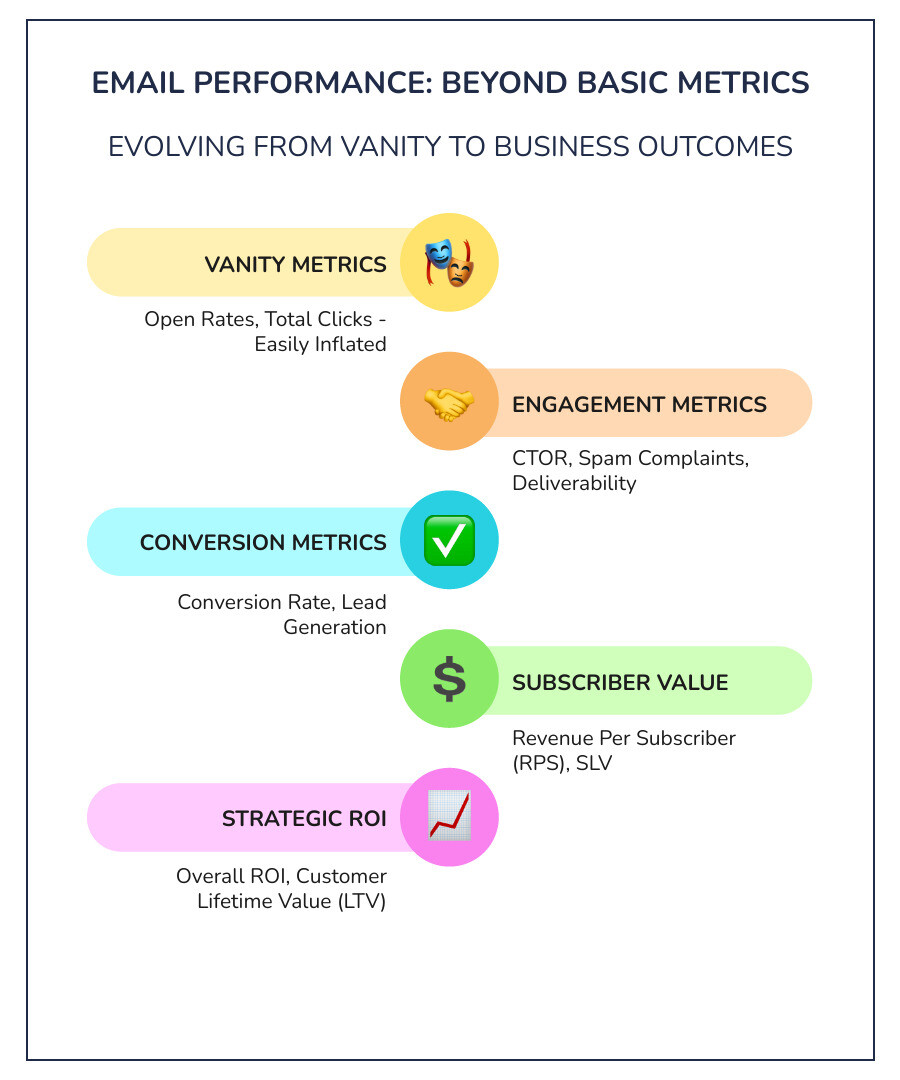Beyond the Open Rate: Mastering Email Marketing Performance
Master your email marketing program performance. Go beyond opens to drive ROI, conversions & brand value with data-driven strategies.
Master your email marketing program performance. Go beyond opens to drive ROI, conversions & brand value with data-driven strategies.

Email marketing program performance is the measurement of how your email campaigns achieve specific business objectives, from engagement to revenue. While many tech founders focus on vanity metrics like open rates, true performance lies in tracking conversion rates, subscriber lifetime value, and return on investment (ROI).
Key performance indicators (KPIs) fall into three categories:
The challenge isn't sending emails—it's understanding which metrics drive growth. While 47.5% of marketers find their email strategy very effective, many struggle to connect campaigns to business outcomes. With email lists decaying by about 22.71% annually, performance tracking is essential for sustainable growth.
As Tony Crisp, founder of CRISPx, I've helped tech startups from UC Irvine to Fortune 500 companies like Nvidia and HTC Vive optimize their email marketing program performance. My experience is rooted in data-driven strategies that connect every campaign to measurable brand value and revenue.

Email marketing program performance terms at a glance:
High open rates feel good, but they don't always translate to revenue. The real challenge isn't collecting data—it's knowing which metrics matter for business growth. At CRISPx, we've learned that moving from vanity metrics to value-driven measurements is what separates successful email programs from expensive digital postcards.
Think of it this way: engagement metrics tell you if people are paying attention, while business-outcome metrics tell you if they're taking action. Both matter, but they serve different purposes. List health and deliverability form the foundation—because even the most compelling email won't work if it never reaches the inbox.
Our approach focuses on actionable metrics that connect directly to our LaunchX framework, where every metric ties back to building authentic brand value rather than chasing vanity numbers.
Click-Through Rate (CTR) is where engagement becomes tangible. It measures the percentage of recipients who clicked a link, requiring real action. A good CTR is in the 2-5% range. It's an honest metric because it reflects genuine interest in your content or offer.
Click-to-Open Rate (CTOR) digs deeper, measuring the percentage of openers who also clicked. A high open rate with a low CTOR suggests your subject line is promising more than your content delivers.
Spam complaints are critical for deliverability. Keeping this below 0.1% protects your sender reputation. The key is ensuring your content aligns with subscriber expectations.
List growth rate is vital because email lists naturally decay by about 22.71% annually. Tracking growth ensures your acquisition strategy is outpacing natural attrition.

This is where email marketing program performance gets serious about your bottom line. These metrics measure impact, not just activity.
Conversion rate is the ultimate test, measuring how many people took a desired action (e.g., purchase, demo request) after clicking. High conversion rates signal a perfect match between your message, audience, and timing.
Subscriber Lifetime Value (SLV) reveals the long-term worth of each person on your list. For tech companies with subscription models, this metric justifies investment in acquisition and retention.
Revenue Per Subscriber (RPS) provides immediate feedback on your list's financial performance. We track this to spot trends and optimize campaigns, with automated flows typically generating the highest RPS.
Overall Return on Investment (ROI) is the gold standard for proving value. Our LaunchX framework ensures every email doesn't just drive conversions but also builds lasting brand value, turning your email program into a sustainable competitive advantage.
Understanding your email marketing program performance requires digging deep into data, comparing it against industry standards, and identifying nuances that open up growth. At CRISPx, we turn raw data into actionable insights.
Effective tracking is the backbone of a successful email strategy. We recommend a multi-faceted approach:
While your own historical performance is the most important benchmark, industry averages provide valuable context. They help you see where you're excelling and where there's room for improvement.
Here's a snapshot of average email marketing statistics by industry (data last updated December 2023):
| Industry | Avg. Open Rate | Avg. Click Rate | Unsubscription Rate |
|---|---|---|---|
| Business + Finance | 31.35% | 2.78% | 0.15% |
| Non-Profits | 40.04% | 3.27% | 0.18% |
| Education + Training | 35.64% | 3.02% | 0.18% |
| Ecommerce | 29.81% | 1.74% | 0.19% |
| All Users (Overall) | 35.63% | 2.62% | 0.22% |
Source: Mailchimp Data
Non-Profits and Education often see higher engagement due to mission-driven content. Ecommerce, in contrast, must focus heavily on conversion rates to drive sales.
Tracking email marketing program performance isn't without its problems:
Measurement is just the beginning. Real magic happens when you transform insights into strategic growth. At CRISPx, our LaunchX and OrbitX methodologies work together to lift your email effectiveness. LaunchX builds authentic brand value, while OrbitX uses behavioral psychology to drive growth.
Your email marketing program performance is about building lasting brand equity. Our LaunchX framework ensures each email authenticates your brand and deepens customer relationships.
While LaunchX builds your brand, OrbitX leverages growth marketing psychology to drive action. It's about understanding behavior to anticipate needs.

Artificial intelligence is changing email marketing program performance today. We integrate AI to increase quality and efficiency, achieving better results with less manual effort.
Metrics and optimizations must translate into real business impact. At CRISPx, we ensure your email marketing program performance drives tangible outcomes, connecting every email to your bottom line.
If you can't prove your email marketing is making money, you can't justify the investment. We make ROI calculation transparent.
The ROI formula is: [($ Additional Sales - $ Campaign Cost) / $ Campaign Cost] * 100. A campaign generating $10,000 in sales from a $1,000 investment yields a 900% ROI.
The key is accurately tracking campaign costs versus revenue. We account for all costs (platform fees, content, staff hours) and use precise UTM parameters to attribute sales to specific campaigns. Our proprietary DOSE Method™ (Data, Optimization, Strategy, Execution) ensures every campaign is structured for clear ROI reporting, treating your email program as an investment vehicle designed for consistent returns.
Email marketing doesn't exist in a vacuum. Its success is tied to your overall business strategy.
We get a lot of questions from tech founders about email marketing program performance. Here are the most common ones.
A good CTR is typically 2-5%, but this varies by industry. More importantly, focus on improving your CTR over time against your own historical benchmarks. Also, consider your click-to-open rate (CTOR) to gauge content engagement.
Use the formula: [($ Additional Sales - $ Campaign Cost) / $ Campaign Cost] * 100. The key is to carefully track all campaign costs and use UTM parameters to accurately attribute revenue to specific emails.
Privacy features like Apple's Mail Privacy Protection pre-load email content, which inflates open rate data. Because of this, it's better to focus on more reliable engagement metrics like click-through rates and conversions.
Focus on metrics that show business impact. These include engagement metrics (CTR, CTOR), business-outcome metrics (conversion rate, revenue per subscriber, ROI), and list health metrics (bounce rate, deliverability).
Improve effectiveness through strategic segmentation, personalization, and automation. Welcome series and cart abandonment flows are powerful tools. AI can further improve this by optimizing send times, subject lines, and content for you.
Effective tracking requires proper setup. Use UTM parameters on all links, integrate your email platform with your main analytics tool, and build dashboards that highlight the KPIs tied to your business goals. Analyze trends over time, not just single campaigns.
Benchmarks provide context (e.g., Non-Profits often have higher engagement, while Ecommerce focuses on conversions), but your most important comparison is your own performance history. Aim for continuous improvement against your own data.
Email directly impacts key business goals like lowering Customer Acquisition Cost (CAC) and increasing Customer Lifetime Value (LTV). The data can also inform product strategy and empower sales teams. A strong email program is a growth engine for the entire business.
We've moved beyond vanity metrics to see what true email marketing program performance looks like: a systematic approach that connects every email to real business outcomes. This shift doesn't happen overnight, but by focusing on conversion rates, subscriber lifetime value, and ROI, you build a powerful growth engine.
At CRISPx, our methodologies are designed for this purpose. Our LaunchX framework ensures every email builds brand value and trust. The OrbitX approach uses behavioral science and AI-powered personalization to turn subscribers into customers. This combination of data-driven strategy and AI-improved execution is what gives our clients a competitive edge.
Your email list is an asset that requires constant nurturing. By applying our DOSE Method™ (Data, Optimization, Strategy, Execution), you don't just fight list decay—you continuously improve the quality of every interaction. When you get this right, email becomes the foundation that supports all your marketing efforts, turning subscribers into loyal advocates and driving sustainable growth.